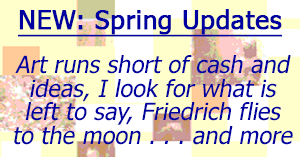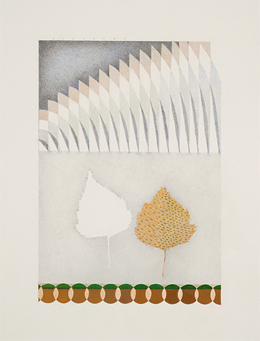When a summer group show takes as its theme “Abstraction from Nature,” you can only wonder: how could no one have thought of this before? It makes that much sense. You may wonder, too, though, what so broad a theme could possibly leave out. With drawings like these, at McKenzie through August 18, the answers lie in the details. This is art from an active eye and hyperactive pencil, brush, or pen.
It is not just a cliché to compliment art after nature as approaching abstraction. I felt the urge just this month in Tribeca, as I noted last time, with JP Munro. It is just as common to speak of abstract art as abstracting away. With Susan Vecsey in Chelsea, at Berry Campbell through August 11, horizontal bands of close colors, often blue, hint at the horizon, sky, or sea. The gradual narrowing of one band is more suggestive still, of a road in linear perspective running alongside nature into depth. Back when, critics who disdained realism might make an exception for landscapes by Fairfield Porter—and, like Robert Rosenblum, find an antecedent to Abstract Expressionism in the Hudson River School and Northern Romantic tradition.
The New York School had no trouble leaving New York, at the very least in summer. Painters then could afford the Hamptons (and maybe a loft in Soho). The nine artists in “Abstraction from Nature” are not so lucky, but they still find nature everywhere they look, starting in the city. Abby Goldstein speaks of urban walks, Sarah Walker of collecting fallen leaves. Chris Arabadjis does his drawing on a two-hour commute. But then I run into fine flowers by Nancy Blum whenever I catch the subway, for she has tiled the nearest station.
When it comes to life in the subways, you may think first of germs. Arabadjis invokes instead tree rings, whirlpools, rock formations, and mycelia—the threads in fungi. If that sounds strange, they are all networks, tilings, or eddies. They are also rule-based, like his drawing. This Lower East Side gallery has a commitment to geometric abstraction, like that of Don Voisine, Gary Petersen, and more from past reviews than I can list here. Yet it also has a genuine fondness for surfaces, signs, and symbols.
That can mean obsessive patterning, of a kind that cannot help disrupting the pattern. Laura Sharp Wilson speaks of Defying a Brutal Art. It can lead to a search for optical activity as well, akin to Op Art, like Wilson in acrylic and Walker lending nature her electric color. Webs by Katia Santibañez seem to vibrate, as does paper itself for Marian Williams. Her pen adds a shimmering blue.
 What they do not do is to hover between nature and abstraction. Almost everything here falls within one or the other. One will just have to take Santibañez at her word that her abstract webs look outward to spiders. Blum in fact produces two bodies of work for the show’s twin inspirations. Pencil weaves through her black paper or radiates outward. White clay butterflies hang high on the wall.
What they do not do is to hover between nature and abstraction. Almost everything here falls within one or the other. One will just have to take Santibañez at her word that her abstract webs look outward to spiders. Blum in fact produces two bodies of work for the show’s twin inspirations. Pencil weaves through her black paper or radiates outward. White clay butterflies hang high on the wall.
Their shared strength may lie less in the image, real or abstract, than in the artist’s hand. Jessica Deane Rosner could be denying both, with the appearance of collage in pencil, ink, and acrylic. Others, though, dedicate their work to the medium itself, like Katia Santibañez with her vibrations and Denise Sfraga with colored pencil. And that returns to a nagging question in art today. As painting proliferates and genres lose their meaning, what does that leave for abstract art? After all these years, the media may still be its message.
Read more, now in a feature-length article on this site.
